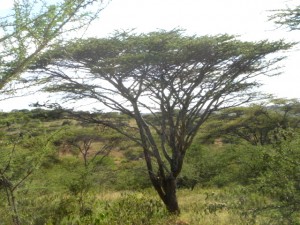 This is going to be tough, to distill “paleo” into a short pithy post, but I’ll try.
This is going to be tough, to distill “paleo” into a short pithy post, but I’ll try.
Take George Clooney. If he spread his arms out wide, they’d span about six feet. Now, imagine his outstretched arms representing the two or so million years humans have been around. With that in mind, the time since we started farming is represented by less than the length of his middle fingernail. So most of his six foot arm span is the time we were foraging for food. We’ve been hunter-gathers for most of our time since leaving the trees.
It’s estimated we’ve changed (genetically speaking) less than one percent since farming started around ten thousand years ago. That’s not much change. During all that time before farming started our bodies became fine tuned to what was provided by living as hunter-gathers.
For food, we would have sought out but rarely found much in the way of sweets, instead we ate animals, fish, leafy vegetable, berries and some fare like bugs and grubs that grosses most of us out . We aren’t adapted yet to thrive on our current diet of simple sugars, grains and dairy.
Currently, with our incredible successes as farmers, grains and simple sugars are cheap and widespread, fueling humans around the world. We’re like diesel engines supplied by fuel tanks of gasoline. We might occasionally add a quart of oil to the gasoline to make the fuel a little more compatible, but the little diesel engines aren’t running too well.
Apparently, preagricultural humans were felled by childbirth, infection and traumatic injury. And the ones who dodged those bullets, were taller, stronger and longer lived than our more recent ancestors who became farmers. Hunter-gathers didn’t suffer much from the diseases of civilization like obesity, heart problems and the cancers affecting us now.
Every account I’ve seen of healthy native populations encountering and then embracing a western style diet soon fell prey to the same constellation of ailments associated with the more technologically advanced population who introduced the refined diet to them.
This is a broad area to look at. But there’s good reason to do so. And most people looking at how our ancestors lived come away with insights on how to improve their lives today, and not by picking up a spear and eating grubs.
This is about the clues to the environment humans adapted to over the millenia. Look at “The Black Swan” author, Nassim Taleb, he’s erudite and urbane, spending his time (away from the outdoors) in cities around the world. But by paying attention to these clues from our ancestors he’s able to better live in his modern world. Wealthy enough to do as he pleases and travel often, he says “I was able to re-create 90 percent of the benefits of the hunter-gatherer lifestyle with minimal effort, without compromising a modern lifestyle, in the aesthetics of an urban setting.”
This is a broad area for investigation. Humans are tool users and seem to not like rules. So here are a some of the take-away tools I think are useful:
Avoid sugars and grains and embrace meat, fish, leafy vegetables, berries and nuts. Skip meals sometimes. Sleep longer, in complete darkness. Become an occasional sprinter instead of jogging regularly. Get a little sun. Walk a lot. And finally, randomly do some brief but very intense exercise.
Here’re a few places to start looking if you want more information:
PaNu – the site of a board certified MD with his thoughts about Paleolithic nutrition and modern life, a very good source to start with. He’s a busy guy, so his site is not updated very often but that’s ok.
Mark’s Daily Apple – this site serves up good solid information, but with distracting contests and self promotions.
Evfit – an old school website layout but chock full of good information.
This is a big subject I’ll revisit in later posts, I hope this was a useful introduction for you.
 When in NYC, you’ll soon notice all the abandoned bikes or more commonly, what’s left of them chained with oversized chains to immoveable objects.
When in NYC, you’ll soon notice all the abandoned bikes or more commonly, what’s left of them chained with oversized chains to immoveable objects.
